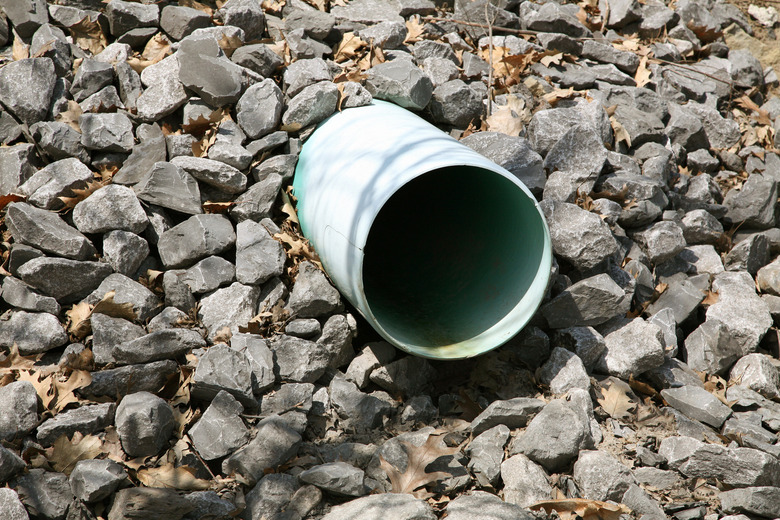How To Lay Landscaping Fabric Behind A Retaining Wall
Retaining walls can be built with a range of materials — cement, wood, natural stone and concrete blocks are all commonly used. No matter what material you choose, every retaining wall should include a provision to collect and drain the water that seeps through the ground behind it, or the weight of the saturated soil can cause the wall to fail. The typical method is to install a perforated drainage pipe at the bottom of the wall. The pipe needs to be surrounded by gravel that should extend from the pipe at the base all the way to the top of the wall. A key step to prevent clogging and keep the drainage feature working in the long run is to surround the gravel and pipe with landscape fabric on all sides.
Step 1
Step 1
Measure the distance from the top of the retaining wall to the bottom of the excavated area behind it, across the bottom at ground level and back up the other side to the height of the original grade. This determines the necessary width of the landscape fabric. Measure the length of the retaining wall to determine the length of the fabric.
- Retaining walls can be built with a range of materials — cement, wood, natural stone and concrete blocks are all commonly used.
- The pipe needs to be surrounded by gravel that should extend from the pipe at the base all the way to the top of the wall.
Step 2
Step 2
Add about 10 percent to the length and width you measured, and cut the fabric to size.
Step 3
Step 3
Lay the fabric in the space between the wall and the slope so the entire surface area of each is covered. A bit of the fabric should be left hanging over the top of the wall and the top of the slope.
Step 4
Step 4
Cut the perforated pipe 2 or 3 feet longer than the length of the wall and lay it on top of the fabric at the base of the wall. The pipe should extend several feet beyond the end of the wall.
Step 5
Step 5
Backfill the area behind the wall with gravel to within 6 inches of the top of the wall.
Step 6
Step 6
Fold the remaining flaps of landscape fabric over the top of the gravel and cover it with topsoil to fill in the remaining distance to the top of the wall. The area can now be mulched or seeded with grass.
- Add about 10 percent to the length and width you measured, and cut the fabric to size.
- Cut the perforated pipe 2 or 3 feet longer than the length of the wall and lay it on top of the fabric at the base of the wall.
Tip
Use more than one sheet of fabric, if necessary, to cover the entire length and width of the wall. Overlap the sheets of fabric by 10 or 12 inches so soil and roots do not work their way through the gaps.
Warning
Consult with a professional contractor or landscape architect when you're working with large retaining walls. Walls over 3 feet high must meet special design and engineering requirements and may require a building permit.
Things Needed
- Tape measure
- Scissors
- Landscape fabric
- Perforated pipe
- Gravel
